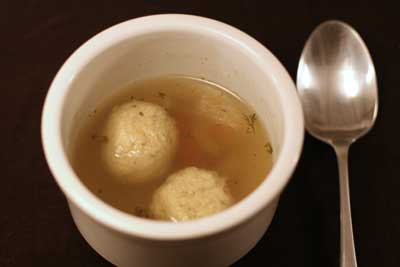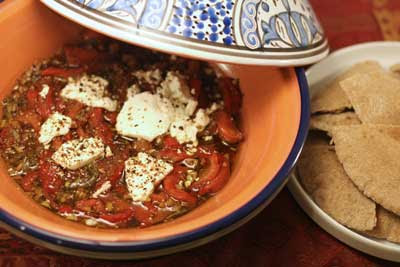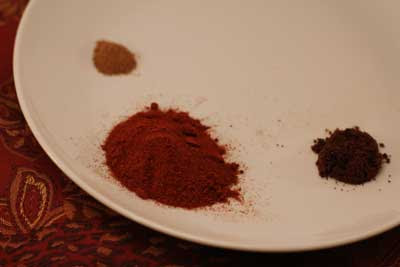 This recipe for Issan Samaga Wattakka Soup is similar to the recipe for Soupa de Jerimum, a Portuguese dish. This is most likely attributed to the Portuguese influence in Sri Lanka during the Colonial Period when Portugal's trading empire stretched from Lisbon to most of East Asia.
This recipe for Issan Samaga Wattakka Soup is similar to the recipe for Soupa de Jerimum, a Portuguese dish. This is most likely attributed to the Portuguese influence in Sri Lanka during the Colonial Period when Portugal's trading empire stretched from Lisbon to most of East Asia.The flavors of these two soups are quite different, however, as Issan Samaga Wattakka features shrimp instead of sausage. Issan Samaga Wattakka is also seasoned with spices popular in Indian cuisine such as cumin and coriander while Soupa de Jerimum relies on parsley and sage.
Recommended Equipment:
blender or food processor
large pot or Dutch Oven with a lid
Ingredients:
1/2 (approximately 4 1/2 pound pumpkin)

2 tbsp extra virgin olive oil
1/2 tspn kosher salt
3 + 2 tbsp butter, unsalted
3 tbsp all-purpose flour
2 cups yellow onions, diced
1 leak (white portion until it turns a deep green), sliced into rounds
1 bay leaf
2 tspn brown sugar
1 tspn ground black pepper
2 tspn coriander, ground
2 tspn cumin seeds, ground
1 tspn chile powder
1 tspn cayenne powder
1 32 oz. box of chicken stock (about 5 1/2 cups)
2 tbsp vinegar
3 cloves garlic, minced
10 tiger shrimp, peeled and deveined
Preparation:
- Cut the pumpkin in half and remove the seeds and stringy interior. Reserve the seeds for garnish (see recipe for baked pumpkin seeds). Cut the tough outer layer of the pumpkin from the softer flesh of the interior. Cut the flesh into small 1/2 to 1 inch cubes.

- In a mixing bowl, combine the pumpkin cubes, 2 tbsp olive oil, and 1/2 tspn salt.
- In a large pot or Dutch oven over medium heat, add 3 tbsp butter and 3 tbsp flour. Stir the mixture continuously for about 5 to 7 minutes until the mixture becomes the color of peanut butter.
- Add the pumpkin cubes and cook for 10 minutes.
- Add the onions, leek, brown sugar, black pepper, coriander, cumin, chile powder, and cayenne.
- Cook over medium heat until the onions become clear and translucent.
- Pour mixture into a blender or food processor and puree.
- Pour the pureed pumpkin mixture back into the large pot and add the chicken stock, bay leaf, and 2 tbsp of vinegar.
- In a skillet over medium heat, place 2 tbsp butter and the minced garlic. Cook for 2 minutes.
- Add the shrimp to the skillet and cook until the shrimp turns color about 3 minutes.
- Remove the shrimp and pour the garlic and butter to the pot.
- Chop up 1/2 of the shrimp into small pieces and then add all of the shrimp to the pot.
- Serve hot garnished with baked pumpkin seeds.
 Sri Lanka [ print this recipe for Issan Samaga Wattakka Soup ]
Sri Lanka [ print this recipe for Issan Samaga Wattakka Soup ]

 Legend has it that risotto Milanese dates back to 1574, when a stained-glass artisan, Zafferano, added the saffron he used for his paintings to his daughter's wedding risotto. It became (and still is) the talk of the town!
Legend has it that risotto Milanese dates back to 1574, when a stained-glass artisan, Zafferano, added the saffron he used for his paintings to his daughter's wedding risotto. It became (and still is) the talk of the town! Italy [
Italy [  Holupki originated in Poland but is popular and is known by other names throughout Eastern Europe. They are made with a mixture of ground beef and pork formed into a fist sized ball. This is then wrapped in lightly steamed cabbage and cooked slow and low with sauerkraut and tomato sauce.
Holupki originated in Poland but is popular and is known by other names throughout Eastern Europe. They are made with a mixture of ground beef and pork formed into a fist sized ball. This is then wrapped in lightly steamed cabbage and cooked slow and low with sauerkraut and tomato sauce.


 Poland [
Poland [  There are hundreds of different kinds of curry, but I like this one because the red curry sauce gives the fish a delicious tangy flavor.
There are hundreds of different kinds of curry, but I like this one because the red curry sauce gives the fish a delicious tangy flavor. Thailand [
Thailand [  Velouté is a basic sauce that along with
Velouté is a basic sauce that along with  France [
France [  Chicken Vindaloo comes from Goa, the former Portuguese trading outpost on the West Indian coast. It is a unique fusion of Indian and Portuguese cooking that is now popular in one form or another throughout most of India. It is both sweet and spicy with a hearty chicken based sauce.
Chicken Vindaloo comes from Goa, the former Portuguese trading outpost on the West Indian coast. It is a unique fusion of Indian and Portuguese cooking that is now popular in one form or another throughout most of India. It is both sweet and spicy with a hearty chicken based sauce. India [
India [  In the past, I've mostly used balsamic vinegar in marinades and salad dressing. However, I recently received a sample of
In the past, I've mostly used balsamic vinegar in marinades and salad dressing. However, I recently received a sample of  The Kosher Carnivore: The Ultimate Meat and Poultry Cookbook, by
The Kosher Carnivore: The Ultimate Meat and Poultry Cookbook, by  There might not be a more iconic use of chicken than in “Jewish penicillin,” homemade chicken soup. There’s actually some scientific explanation of why chicken soup has medicinal powers, but for me, it’s all about the taste. One of the best bowls of chicken soup you can find in New York is served nightly at
There might not be a more iconic use of chicken than in “Jewish penicillin,” homemade chicken soup. There’s actually some scientific explanation of why chicken soup has medicinal powers, but for me, it’s all about the taste. One of the best bowls of chicken soup you can find in New York is served nightly at 
 Every Romanian household serves a version of this classic dish. Some insist you chop the eggplant with the side of a ceramic plate, others argue that only wood can come in contact with the temperamental vegetable. Truth is, chop as you please and add garlic and herbs to your taste.
Every Romanian household serves a version of this classic dish. Some insist you chop the eggplant with the side of a ceramic plate, others argue that only wood can come in contact with the temperamental vegetable. Truth is, chop as you please and add garlic and herbs to your taste.
 Romania [
Romania [  These garlicky little bites of ground meat are Romania’s answer to trendy street food. They are crowd-pleasers hot off the grill and served on long bamboo skewers with dipping sauce or simple grainy mustard. The texture of these little sausages can vary from dense and meatball-like to authentic and spongy when seltzer and baking soda are added.
These garlicky little bites of ground meat are Romania’s answer to trendy street food. They are crowd-pleasers hot off the grill and served on long bamboo skewers with dipping sauce or simple grainy mustard. The texture of these little sausages can vary from dense and meatball-like to authentic and spongy when seltzer and baking soda are added.
 Shoo-fly Pie is extremely popular in Pennsylvania however this rustic, mildly sweet molasses treat originated in Canada. Apparently, this pie was named "shoo-fly" because flies would be so attracted to the sweet molasses filling that they had to be constantly "shooooo-ed" away.
Shoo-fly Pie is extremely popular in Pennsylvania however this rustic, mildly sweet molasses treat originated in Canada. Apparently, this pie was named "shoo-fly" because flies would be so attracted to the sweet molasses filling that they had to be constantly "shooooo-ed" away.
 Canada [
Canada [  A couple of weeks ago, we received a review copy of the book, 150 Best Tagine Recipes, by Pat Crocker. The book provides an interesting introduction to Maghreb cuisine – dishes with origins in Morocco, Algeria, Tunisia, and Libya. Crocker provides a detailed overview of the North African flavor footprint complete with profiles of trade-route spices and other Persian flavor agents. Each profile includes the origin of the flavor agent, a description of its taste, as well as its culinary and medicinal uses. Building upon these flavor agents, Crocker also includes recipes for 21 different flavor combinations – spice combinations that serve as key building blocks for many recipes provided later in the book.
A couple of weeks ago, we received a review copy of the book, 150 Best Tagine Recipes, by Pat Crocker. The book provides an interesting introduction to Maghreb cuisine – dishes with origins in Morocco, Algeria, Tunisia, and Libya. Crocker provides a detailed overview of the North African flavor footprint complete with profiles of trade-route spices and other Persian flavor agents. Each profile includes the origin of the flavor agent, a description of its taste, as well as its culinary and medicinal uses. Building upon these flavor agents, Crocker also includes recipes for 21 different flavor combinations – spice combinations that serve as key building blocks for many recipes provided later in the book.

 Eggs are easy to make in the tagine and are a good source of protein for vegetarian meals. This dish is colorful, fresh and very easy to make. It’s another workday lunch or quick dinner. I always use farm fresh large brown eggs in this dish.
Eggs are easy to make in the tagine and are a good source of protein for vegetarian meals. This dish is colorful, fresh and very easy to make. It’s another workday lunch or quick dinner. I always use farm fresh large brown eggs in this dish. Morocco [
Morocco [  Use this as a warm dip for raw vegetables, pita points or crackers.
Use this as a warm dip for raw vegetables, pita points or crackers.
 Very aromatic without being overpoweringly hot, this spice blend is versatile for tangine dishes that include fruit and can even be used in small amounts in sweet dishes and beverages.
Very aromatic without being overpoweringly hot, this spice blend is versatile for tangine dishes that include fruit and can even be used in small amounts in sweet dishes and beverages.
 Morocco [
Morocco [  Sauerbraten is believed to have been introduced in Germany shortly after the arrival of the Romans. The Roman practice of preserving meat in red wine was said to have inspired Germans to prepare meat this way. Today, sauerbraten has several regional variations. It used to be prepared using horse meat, however today it is usually made with beef or veal. It is usually marinaded in a vinegar base for several days creating a tender texture and rich flavor. This recipe uses a shorter marinade process combined with low heat over 7 hours using a slow cooker to produce similar results. Try this recipe with
Sauerbraten is believed to have been introduced in Germany shortly after the arrival of the Romans. The Roman practice of preserving meat in red wine was said to have inspired Germans to prepare meat this way. Today, sauerbraten has several regional variations. It used to be prepared using horse meat, however today it is usually made with beef or veal. It is usually marinaded in a vinegar base for several days creating a tender texture and rich flavor. This recipe uses a shorter marinade process combined with low heat over 7 hours using a slow cooker to produce similar results. Try this recipe with  Germany [
Germany [  A general word for "spices," Baharat may be used to designate several spice blends.
A general word for "spices," Baharat may be used to designate several spice blends.



 Morocco [
Morocco [ 